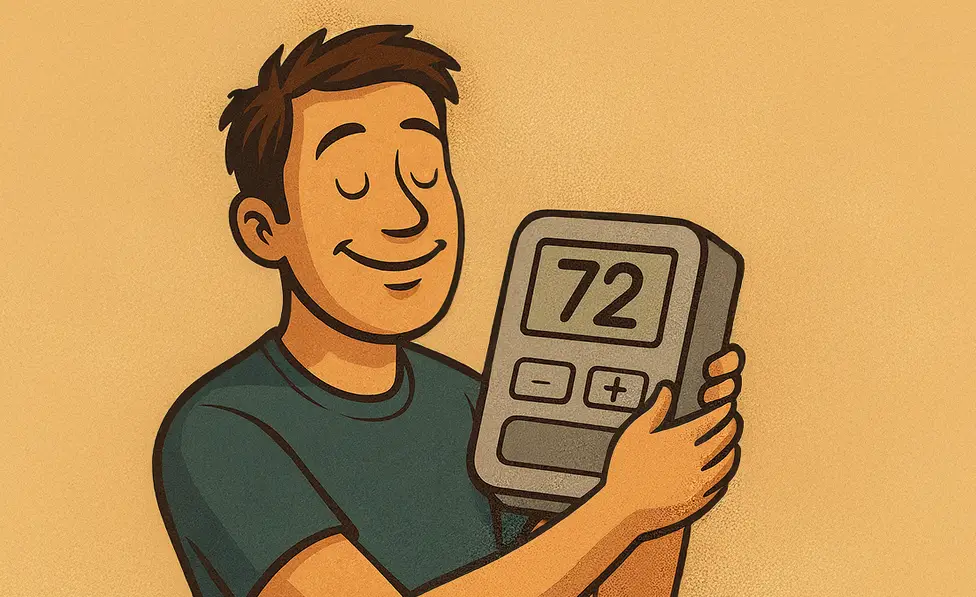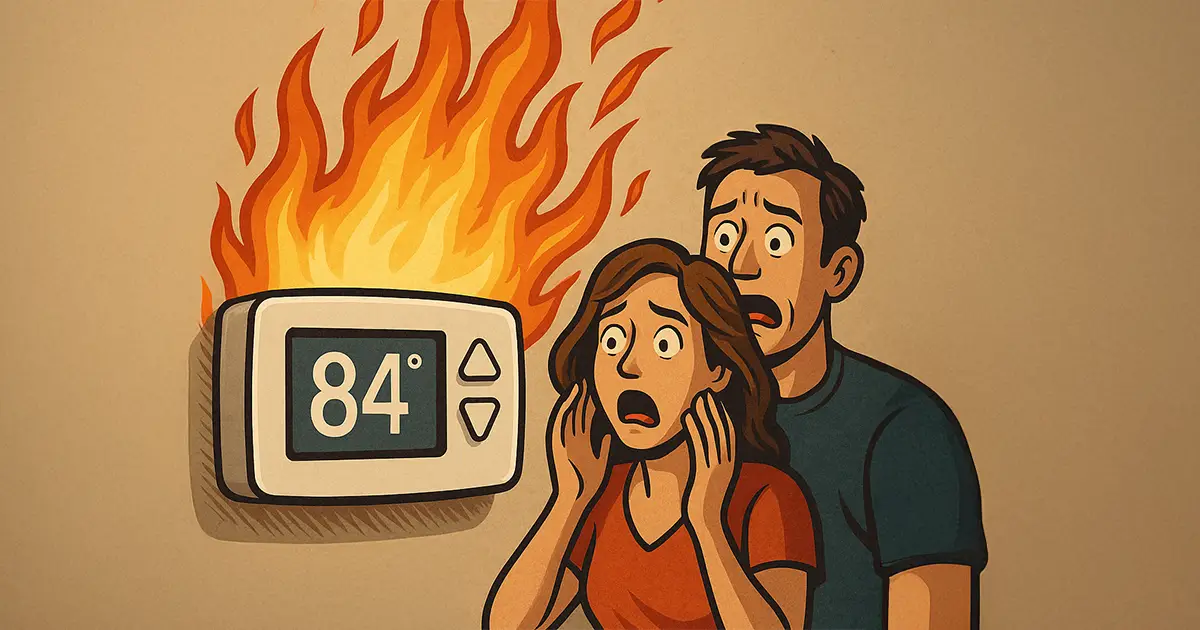Your thermostat looks pretty straightforward, right? Just a little box on the wall with some buttons or a dial. But here’s the thing: how you use it makes a huge difference in your comfort, your energy bills, and how long your HVAC system lasts. Here at A/C Rescue, we’ve been helping homeowners figure this stuff out for years. Yet, unfortunately we see the same mistakes over and over again.
Whether you’ve got an old-school dial, a programmable model, or one of those fancy smart thermostats, it’s easy to fall into habits that cost you money without even realizing it. So let’s talk about what might be going wrong and how to fix it.
Stop Cranking Your Thermostat Up (It Doesn’t Work That Way)
You walk into a cold house on a chilly Dallas morning and immediately crank the thermostat up to 82°F, figuring it’ll heat up faster. We get it. But that’s not how it works.
Your thermostat isn’t a gas pedal. Setting it higher doesn’t make your system work harder or faster, it just makes it run longer until your house hits that higher temperature. So instead of getting warm quickly, you end up overheating your home and paying for way more energy than you needed.
Pick a comfortable temperature (usually around 68 to 70 degrees in winter) and just leave it there. Your system will get you comfortable at its own pace, which is actually pretty efficient when you let it do its thing.
Be Careful with Big Temperature Drops (Especially If You Have a Heat Pump)
Turning your thermostat down at night or when you’re at work is smart. But if you drop it way down and then jack it back up in the morning, you might be triggering something called auxiliary heat, especially if you have a heat pump.
This backup heating system uses electric resistance coils, and it’s expensive to run. Really expensive. Your heat pump is designed to handle most heating needs on its own, but when you ask it to make up a huge temperature difference quickly, it calls in reinforcements.
Keep your setbacks reasonable. Instead of going from 60°F to 70°F all at once, try something like 64°F to 70°F. Better yet, get a smart thermometer that can gradually bring the temperature back up so you never need that costly backup heat. Your bills will thank you.
Running Your Heat All Day Long Costs More Than You Think
Some folks leave their thermostat at a constant lower temperature all day, thinking it’s more efficient to maintain a steady baseline. The logic makes sense, but it doesn’t really pan out in practice.
When nobody’s home for eight or nine hours, you’re heating an empty house. That adds up fast.
Program your thermostat to drop a few degrees during the day and overnight, then warm things back up before you get home or wake up. Modern systems handle these adjustments smoothly, and you’ll barely notice any difference in comfort. But you’ll definitely notice the difference in your energy bill.

Where Your Thermostat Lives Actually Matters
This one surprises people, but thermostat placement can throw off your entire system.
If your thermostat is sitting near a heating vent, next to a sunny window, in the kitchen where the oven runs hot, or above an appliance, it’s getting bad information. It thinks the whole house is warmer or cooler than it really is, so it makes poor decisions about when to run your HVAC system.
The sweet spot? An interior wall about five feet up, in a room you use regularly… somewhere away from drafts, direct sunlight, and heat sources. If you’re renovating or getting a new system, ask your technician to check your thermostat placement. Sometimes moving it just a few feet makes all the difference.
Don’t Leave Your Fan on “On” (Especially in Dallas Summers)
Dallas summers are humid. Really humid. And here’s where a lot of people accidentally make their homes feel even more uncomfortable: they set their HVAC fan to “On” instead of “Auto.”
When your air conditioner finishes a cooling cycle, the evaporator coil is wet with condensation. If your fan keeps running after the AC shuts off, it blows all that moisture right back into your house. You end up with clammy, sticky air and possibly even mold issues.
Keep the fan on “Auto” so it only runs when your system is actively heating or cooling. If you want better air circulation, ceiling fans work great and use way less energy.
Emergency Heat Isn’t for Cold Mornings
If you have a heat pump, you might’ve noticed a setting called “Emergency Heat” on your thermostat. And on a cold Dallas morning, it’s tempting to switch to it, thinking your heat pump needs help.
Don’t do it… unless a tech from A/C Rescue tells you to or your system is actually broken.
Emergency heat bypasses your efficient heat pump completely and runs only the electric resistance coils. It’s like heating your home with a giant toaster. Your electric bill can double or triple in just days.
Heat pumps these days work great even when temperatures drop below freezing. Leave your thermostat on regular “Heat” mode and let the system use auxiliary heat only when it genuinely needs to.
Turning the AC Way Down Won’t Fix Your Humidity Problem
When the air feels thick and sticky in summer, a lot of people crank the AC down to try to remove the humidity. It seems logical, but it usually backfires.
Overcooling your home doesn’t necessarily lower humidity the way you’d expect. Instead, you get cold, damp air that feels uncomfortable in a different way. Plus, keeping your house too cold in humid conditions can actually encourage mold growth and even damage drywall over time.
If humidity is a constant problem, the real solution is better ventilation or a whole-home dehumidifier. Your AC wasn’t designed to be a dehumidifier, and forcing it to do that job doesn’t work well for anyone.
Your Thermostat Needs a Little TLC Too
People forget that thermostats need basic maintenance. Dust and dirt can mess with the sensors, especially in older models. And if yours runs on batteries, weak batteries can cause all kinds of weird issues—inaccurate readings, poor communication with your HVAC system, even complete shutdowns.
Check your thermostat at the start of heating and cooling season. Make sure it’s clean, the batteries are fresh, and the settings look right. If it’s acting strange or giving you wonky readings, it might be time for an upgrade.

Smart Thermostats Really Are Worth It
Still using a basic manual thermostat? You’re leaving money on the table.
Smart thermostat learn how you live. They adjust automatically based on whether you’re home or away. They give you reports on your energy use and tips for saving more. They work with your phone and voice assistants so you can make changes from anywhere.
Some even use weather forecasts and your phone’s GPS to pre-heat or pre-cool your home at just the right time. In Dallas, where we can have a 40-degree temperature swing in a single day, that’s incredibly useful.
According to ENERGY STAR, a properly installed smart thermostat can cut your heating and cooling costs by up to 10%. That pays for itself pretty quickly.
Final Thoughts
We’ve seen how small thermostat mistakes turn into big problems… uncomfortable homes, sky-high bills, systems that wear out too fast. Whether you need help programming a new thermostat, figuring out if yours is in the right spot, or upgrading to a smart system, we’ve got you covered.
If your HVAC system isn’t performing the way it should, or you’re tired of guessing which settings actually work, give us a call at (972) 278-6800. We’ll send one of our experienced technicians to help you get everything dialed in.
Stop guessing. Start saving. Get thermostat help from the pros at A/C Rescue today.

